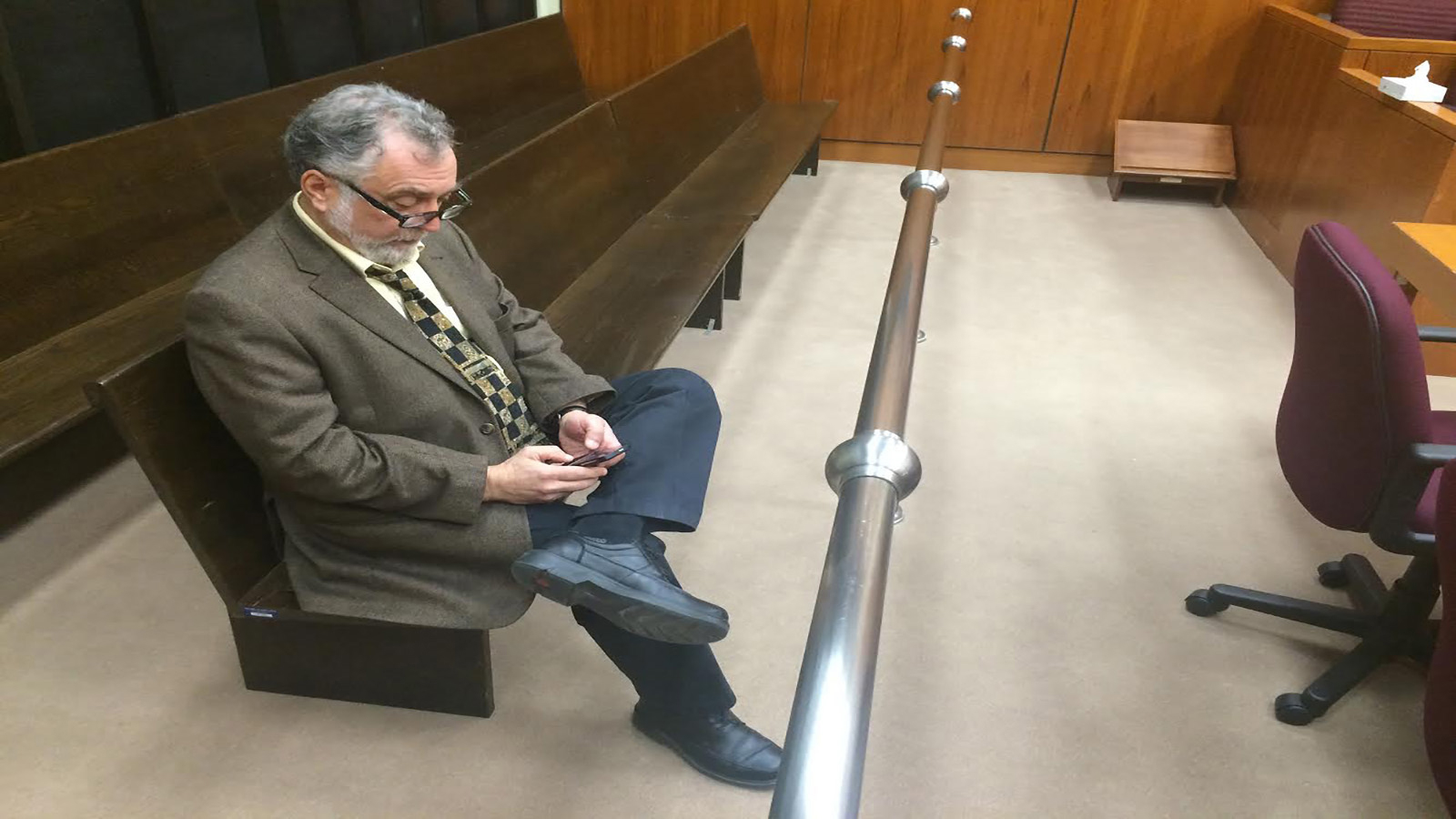Twitter is now in session

caption
John Piccolo, the director of communications for the Nova Scotia Judiciary, reads from his Blackberry in an empty courtroom at the Halifax Law Courts.How does tweeting from the courtroom affect reporting and justice?
One hundred and forty characters do not leave a lot of room for information – in fact, this is exactly as long as the sentence you are reading.
For judges and reporters, the ability to “tweet” in court is a big step (despite the length of the actual messages) towards better accessibility to information, and better judicial practice.
The “whole premise (of the courts),” says Chief Justice Joseph Kennedy, “is based on the fact that we think an informed public will have confidence in the courts.
“We think that the more they know, the better off we’re going to be,” said Kennedy, the chief justice of the Supreme Court of Nova Scotia. “Twitter is the latest technology that allows it.”
Since 2012 every Canadian province and territory has updated its policy on electronic devices in the courtroom, except for Newfoundland and Labrador. Permitted electronic devices include laptops and cell phones, for the purpose of live publishing. Live publishing, or live communication, includes texting, blogging and tweeting.
Generally speaking, from the most open to the least accepting of tweeting in court, the provinces are: Nova Scotia, Ontario, New Brunswick, Nunavut, the Northwest Territories, Yukon, Prince Edward Island, Alberta, Manitoba, British Columbia, Saskatchewan and Quebec. Newfoundland and Labrador currently has no policy in effect.
In August 2014 Kennedy’s comments on the tweets from the Lyle Howe case were published across the country. The justice said he was impressed by the extensive coverage Twitter provided for the trial of a Halifax lawyer accused of sexually assaulting a 19-year-old woman in 2011.
Howe sentenced to 3 years. Angry outbursts as he's led away. One shouts "for now" "sad day for Justice" "systemic racism"
— Blair Rhodes (@CBCBlairRhodes) July 30, 2014
Partially because some of Howe’s supporters claimed the courts were racially biased against him, the case was of particular local interest. With his positive remarks about Twitter, Kennedy inadvertently became an advocate for the new technology policy. In the courts of Nova Scotia, journalists and members of the public can tweet from the courtroom. Only legal counsel and media may publish from youth, family and mental health courts.

caption
Chief Justice Joseph Kennedy, of the Supreme Court of Nova Scotia, sits behind his desk, where he reads tweets during a trial.It’s a position Kennedy finds ironic, considering he has “never twittered anything. I don’t even know what the verb is,” Kennedy said from behind his desk in the Halifax Law Courts. Overlooking the Halifax waterfront, this is where Kennedy checks Twitter, often on Saturday mornings or during a trial.
Twitter provides “much more extensive coverage than (the court) otherwise would get,” he said. As a judge, Kennedy weighs the public’s right to know against justice. “Your overall consideration is to protect the sanctity of that trial, the fair trial.
“The public has as much right to be in that courtroom as I do.”
Canadian courts have an “open court” principle covered in the Canadian Charter of Rights and Freedoms. Under this principle, courts must provide the public with access to its proceedings, so they may understand the court system better. Publication bans can be placed on a trial if enough risk to witnesses or others can be proven before the court. Under these bans, certain information cannot be published on any platform. Some bans, including naming minors or victims of sexual assault, are always in place in Canada.
Two types of policies were developed and discussed in Nova Scotia, says John Piccolo, the director of communications for the Nova Scotia judiciary. The restrictive policy, as Piccolo referred to it, required anyone who wants to tweet in court to ask for permission from the judge prior to the proceedings. The open policy allows anyone to tweet from court, except for jurors. Permission is not required ahead of time. In May 2014 Nova Scotia updated its policy to become the most progressive in the country.
When Amber Kirwan went missing from New Glasgow, Nova Scotia in 2011, missing person posters were papered around her town and the province. Her smiling face made the rounds on social media in a plea for her safe return. And it was through social media that people in every Canadian province and three other countries learned the verdict of her killer.
In January 2014 Dr. Margo Watt, a psychology professor at St. Francis Xavier University, was inspired by Kirwan’s murder trial to study Twitter in court in relation to the case. “Twitter seemed to be the next best thing to being in court,” Watt wrote in an email. Participants of the study said Twitter enhanced their understanding of the trial and proceedings. Many who followed tweets from the trial believed Twitter was more educational and engaging than newspapers, radio or TV.
While the range of restrictions varies from province to province, the Canadian Centre for Court Technology (CCCT) released a set of guidelines for Canadian courts in December 2012. The CCCT is a not-for-profit association of judges and lawyers across Canada. Its mission is to use current technology to modernize the court process and make the courts more open.
The CCCT guidelines were intended “as some form of recommendations,” says Lisa Taylor. An assistant journalism professor at Ryerson University, Taylor was a member of the committee that worked on the guidelines.
Taylor said the guidelines were “looking for an opportunity to find some consistency, to look at what the real or perceived hurdles were to letting people use social media in court.
“Some consistencies in policies would be very useful,” Taylor said. “Not just for journalists, but also for the public in general… people have to understand the nuances of the court.”
Those nuances include who is and who is not a member of the media. The difference decides, in most Canadian courts, whether or not someone may tweet in the courtroom.
Kate Dubinski was sitting on a court bench she says was “uncomfortable, like a church pew,” and covering another trial. But this was not just any trial for the London Free Press reporter. It was 2009, and six members of the Bandidos biker gang were about to be convicted of Ontario’s largest mass murder.
Guns, deaths and thongs – this case had it all. And so did Dubinski’s Twitter feed.
For those following the #bdos trial: Remember I said the Crown put up a picture of a really old gun? Here's the picture: http://bit.ly/eBiYa
— Kate Dubinski (@KateDubinski) October 22, 2009
This particular court bench was not in the same courtroom as the gang, lawyers, witnesses and judge. Instead, Dubinski was watching a livestream on three television monitors. She was in an overflow room in another part of the courthouse, because she was on her Blackberry.
In 2009 all electronic devices were not only turned off in Ontario courts, but also given to the court sheriffs. The London Free Press had permission from the judge for a reporter to live-tweet the case, if she stayed in the overflow room. It was the first trial in Canada with live coverage during the proceedings.
Twitter’s introduction to courtrooms across the country comes with the concern of some judges and reporters. The question is not just Twitter’s character limitations, but also the immediacy and accuracy of each 140-character message. And who can send these messages.
Social media makes it possible for anyone to publish independently and instantly through a blog or another online platform like Twitter. Such websites provide better access to information, but journalists and judges are concerned for court reporting’s credibility.
“Finding the working definition of who is a journalist is not as easy as it used to be,” says Blair Rhodes, a producer and reporter for CBC in Halifax. Rhodes is also the journalism representative on a media liaison committee for the courts of Nova Scotia. He was consulted on the current technology policy. Many people who present themselves as journalists, Rhodes said, “don’t abide by the same ethical standards that (are) expected from the rest of the profession. I have a problem with that because we’re all tarred with the same brush.”

caption
Blair Rhodes, a producer and reporter for CBC Halifax, checks Twitter in a CBC recording studio.Down by the waterfront, Kennedy agrees. “My greatest fear,” he said, “would be of people not knowing what they were doing.”
Court reporters and journalists who work for news organizations often have editors to turn to, as well as lawyers, for publication advice. Journalists have guidelines and experience with the ins and outs of the court system, and know what they can and cannot publish. “We can rely on members of the media to understand those things,” Kennedy said, because the media is careful.
Piccolo, the director of communications, said some issues the courts of Nova Scotia discussed included tainting witnesses, the violation of publication bans and voir dire. Voir dire, often referred to as a trial within a trial, is when the jury is removed from court. If someone tweets during a voir dire – violating the publication ban – the jury could see it, and their absence would be pointless. Likewise, witnesses asked to leave during a portion of a trial could be informed (accidentally or intentionally) about what they were supposed to miss.
Kennedy said he doesn’t even want to talk about such concerns. He is a funny man, who cracks jokes about his age as he waves around a bandaged hand, broken in a recent fall. He is serious now. “It would be so easy,” Kennedy said, for people to share information that disrupts the process of justice. He does not want to give any ideas to people looking to misuse Twitter.
“The judiciary,” said Piccolo, “felt (any problems) could be dealt with on a case-by-case basis.” While these concerns, and their consequences, carry a lot of weight, Kennedy believes in giving the public a “reasonable” benefit of doubt.
Most courts across Canada – including Ontario, P.E.I. and B.C. – restrict the use of electronic devices to media, yet are reluctant to define “journalist.” The Court of Queen’s Bench in the provincial courts of Alberta and Manitoba enforce an accreditation process to become a court journalist, much like the Canadian Parliamentary Press Gallery.
Glen McGregor is a member of the press gallery, and was the second person to live tweet from a Canadian court. Less than two months after Dubinski began tweeting the Bandidos trial in London, McGregor tweeted the trial of the then-mayor of Ottawa, Larry O’Brien, for the Ottawa Citizen.
Edelson says he didn't read media coverage of case during trial. Says he doesn't use Twitter. (I'm wounded.)
— Glen McGregor (@obrientrial) August 5, 2009
Accrediting journalists for court reporting is “fraught with so much peril,” he says, “it’s not worth doing.”
McGregor said Twitter “effectively doubled” his workload during the O’Brien trial. His Twitter feed became his notebook when he had to make the choice between the two. “By tweeting (the trial), I was forced to stay engaged,” said McGregor with a laugh. “I couldn’t start daydreaming, as I often do in trials.”
The “steep learning curve,” Dubinski said, was trying to figure out the important information as it happened. As the 2009 Bandidos trial went on, the first person to tweet from a Canadian courtroom says she became better at knowing “how to be more succinct.
“Now if I ever go to court to report, I automatically tweet,” Dubinski said. “It’s almost like a race – who can tweet out the verdict first?”
Print reporters like McGregor and Dubinski used to publish the details of a court case a day later, “but now, not only can we stay up to speed with broadcasters, we can beat them,” said McGregor. “We all type fast as print journalists, and we’re good with words.”
For journalists and bloggers, Twitter is another tool to compete in the real-time delivery of news.
Likewise, for the court, “it isn’t about the technology,” said Piccolo, but rather, the message it conveys. “It’s about the use of the technology.”
Editor's Note
This story was reported and written by Oct. 17, 2014.

